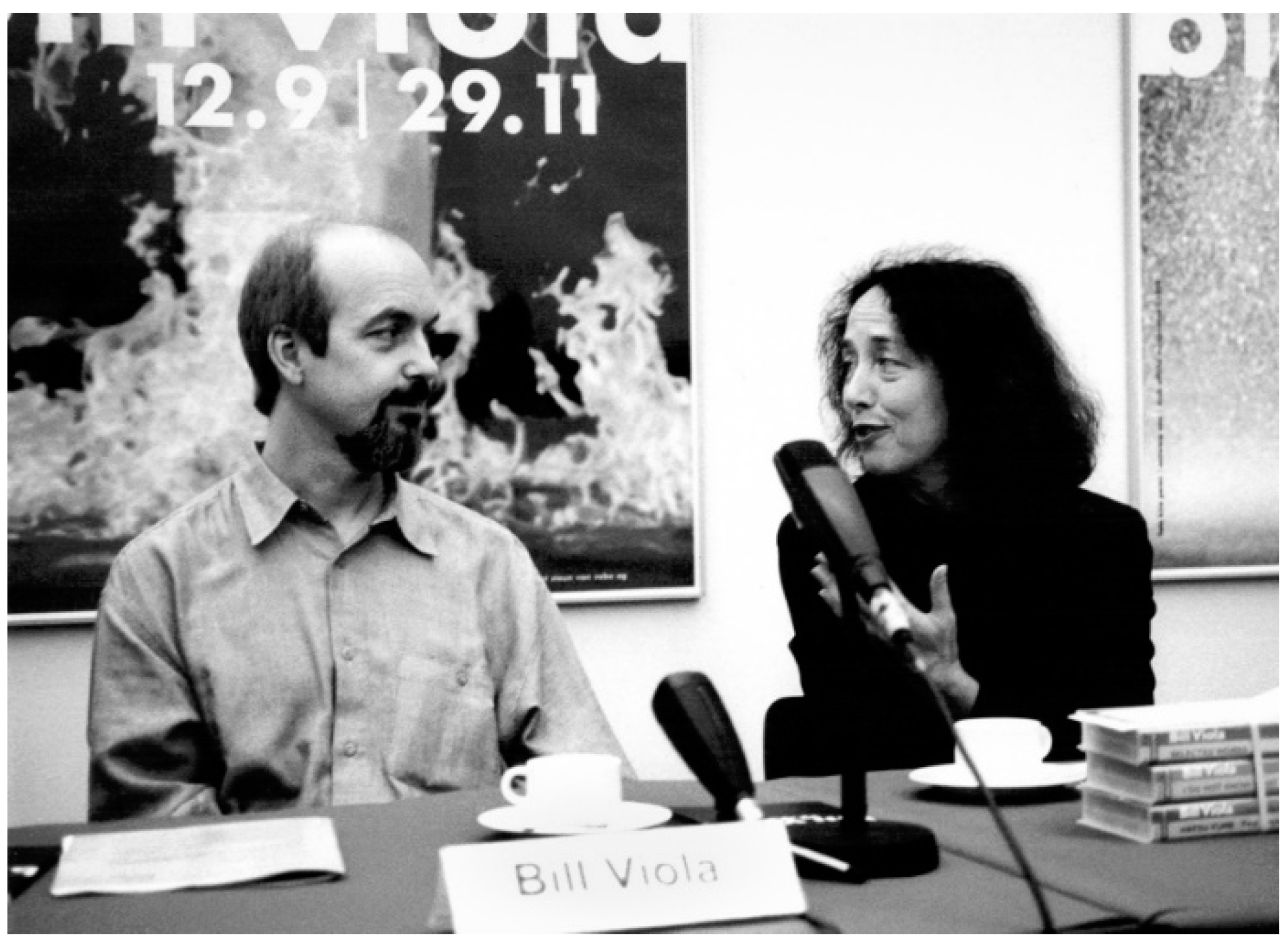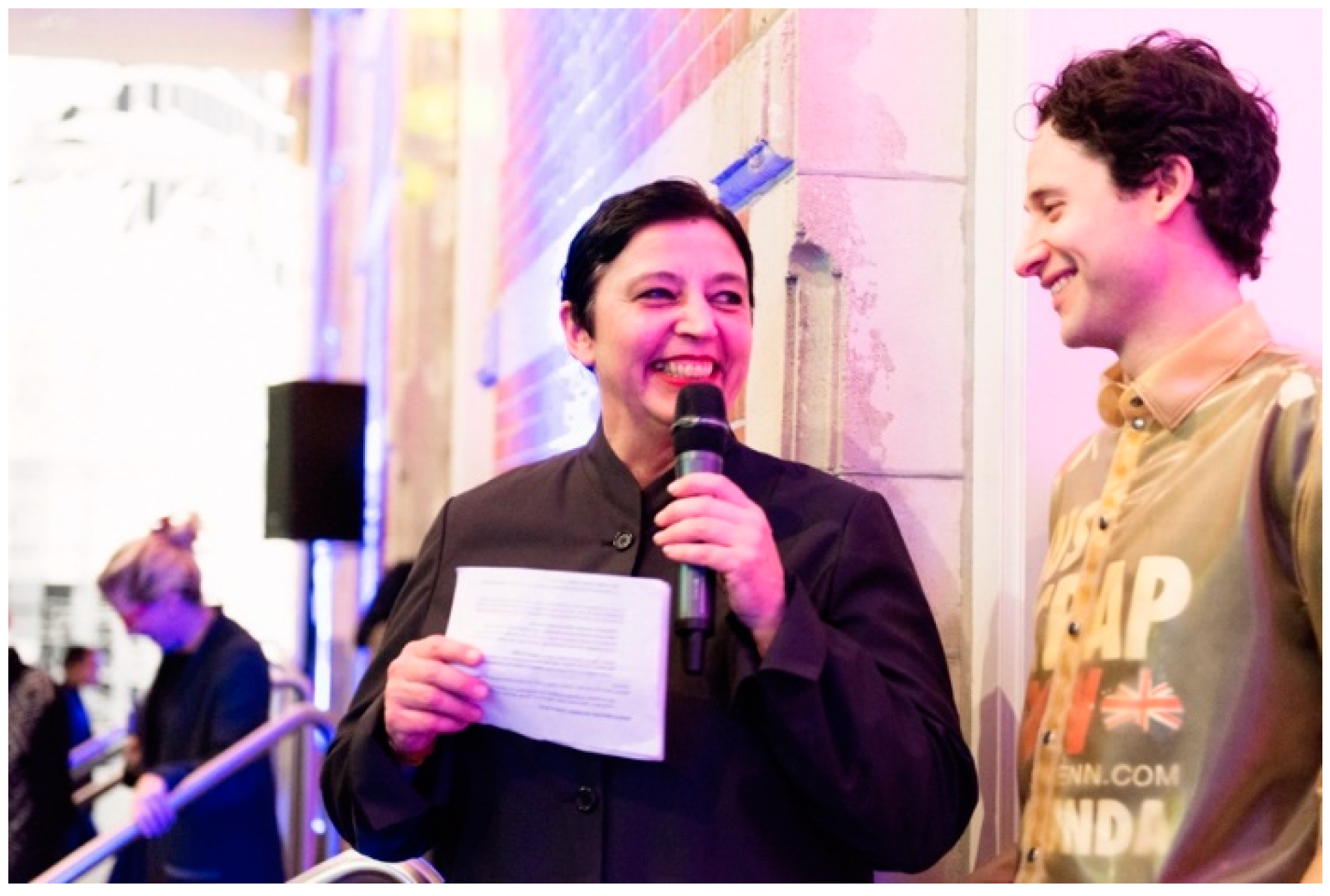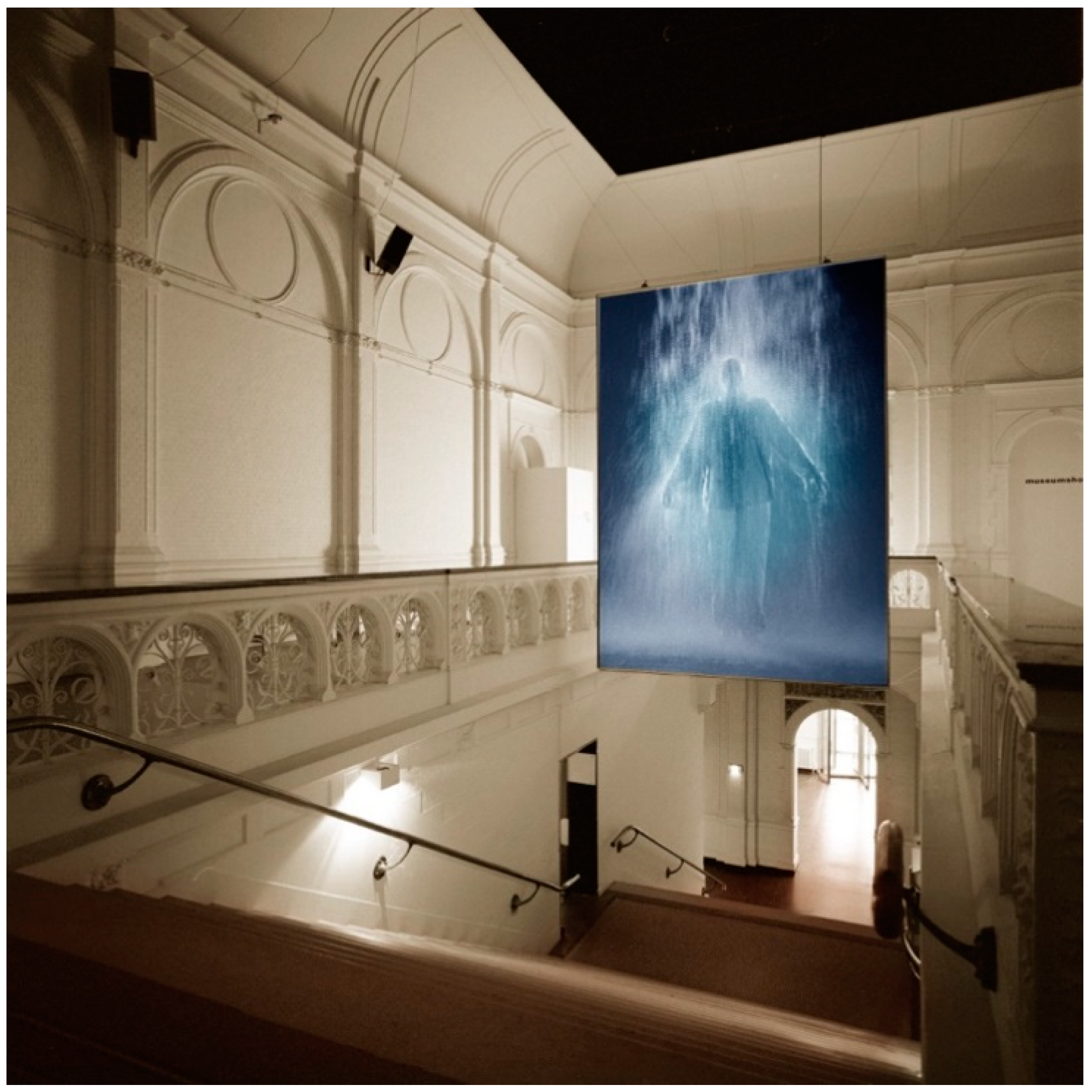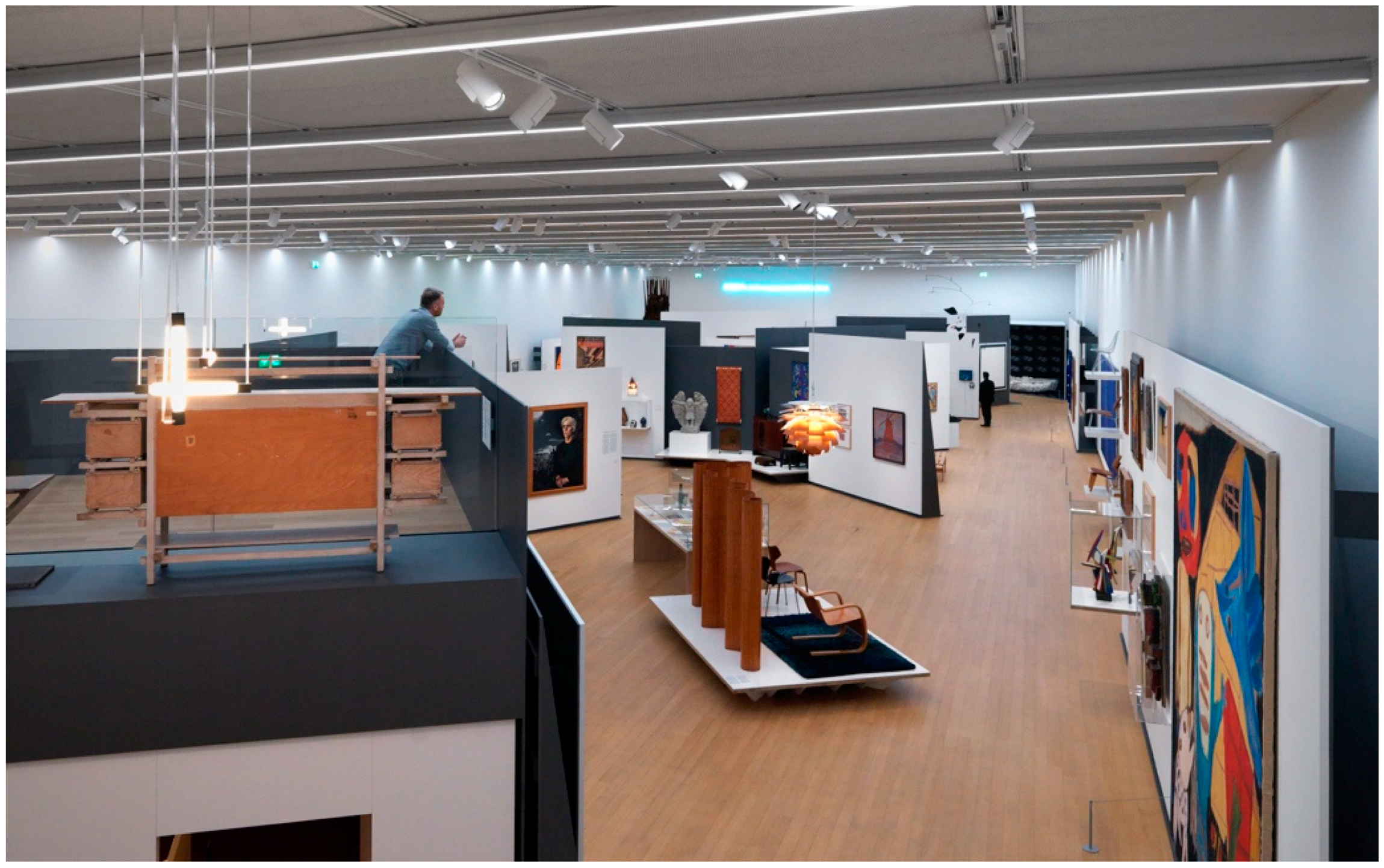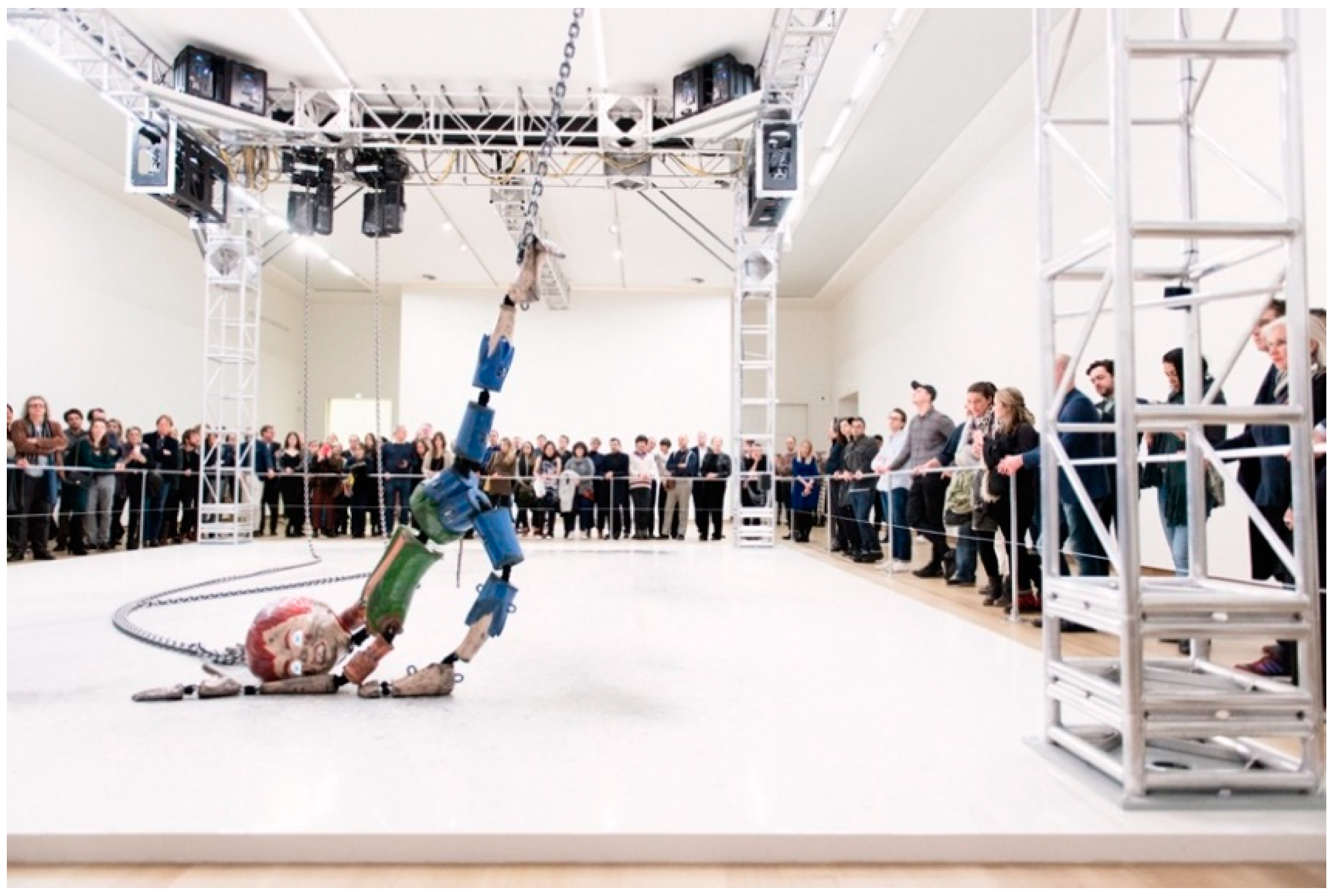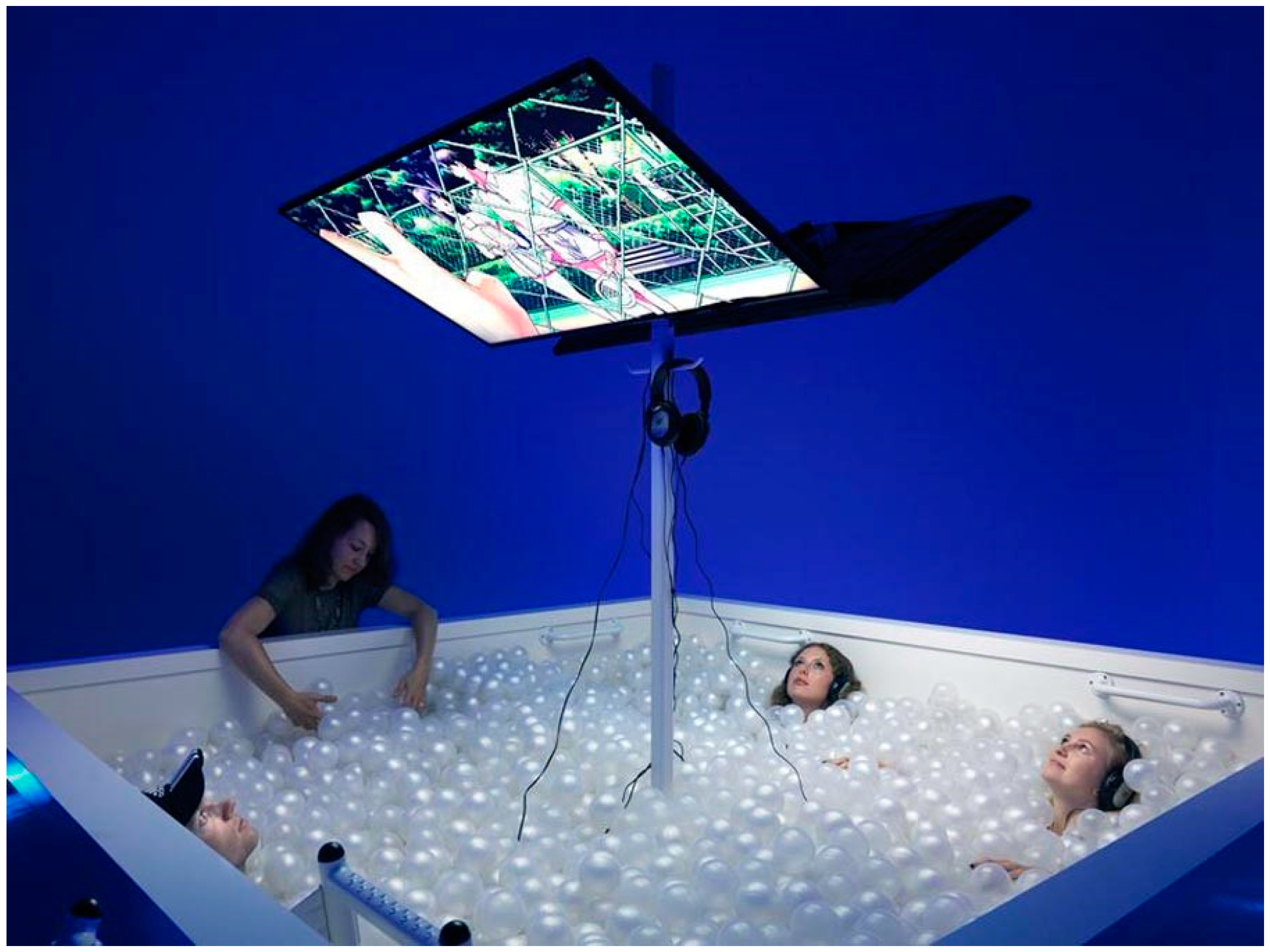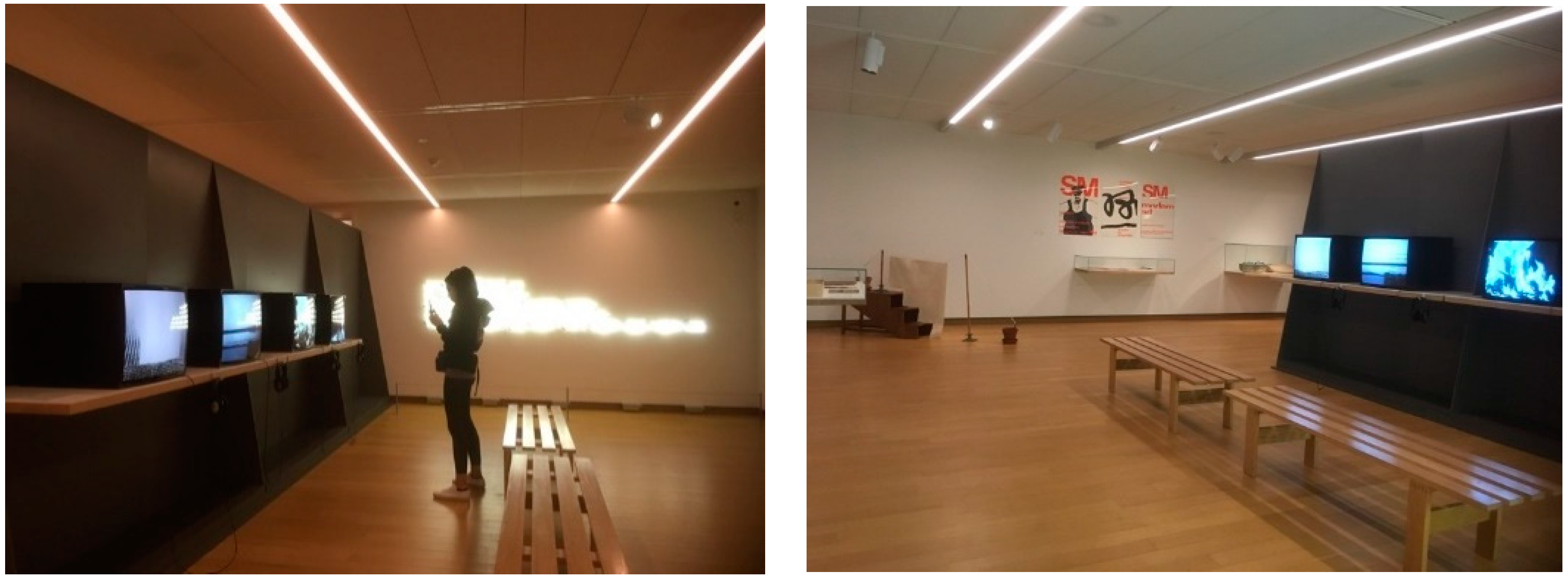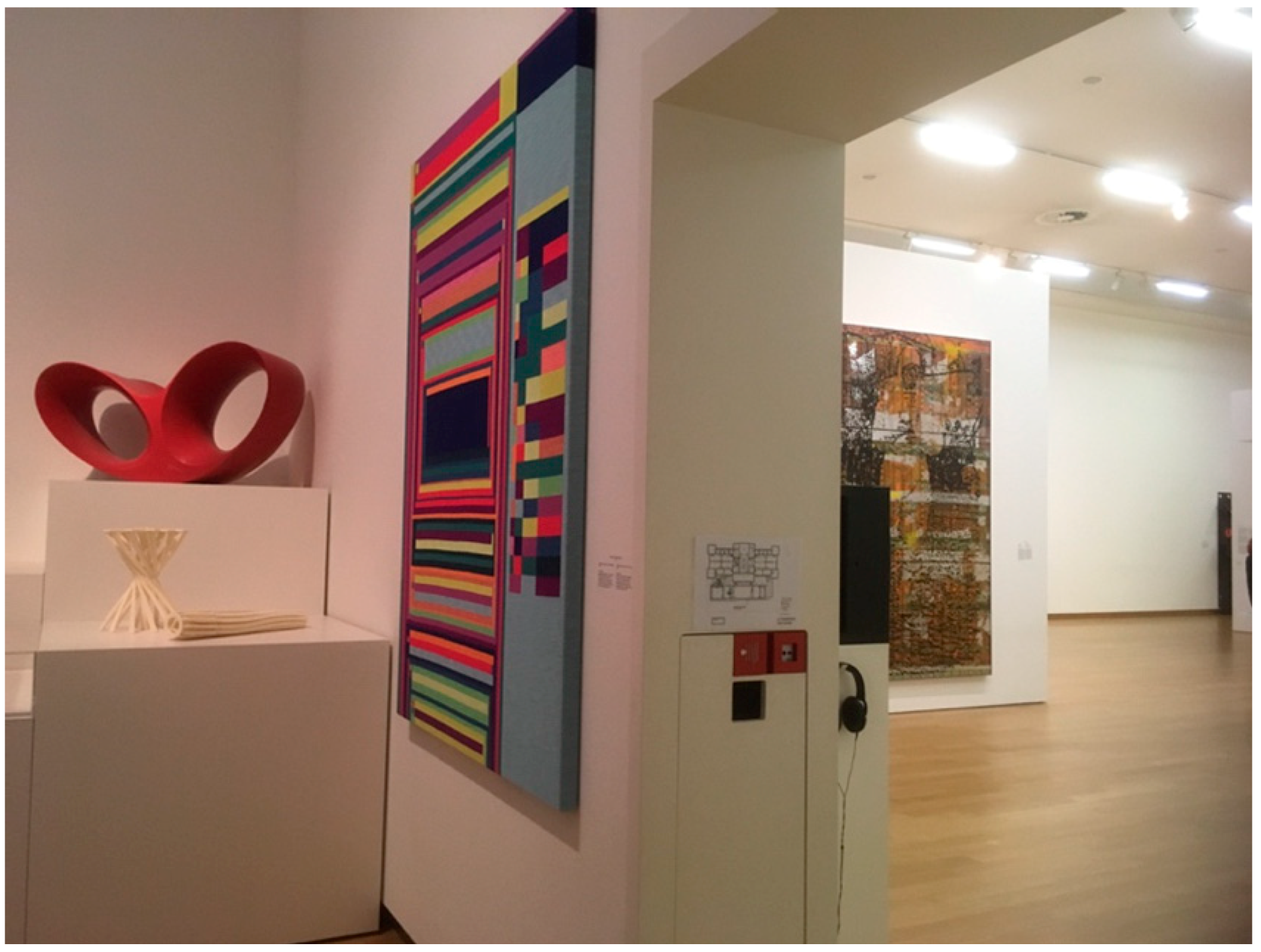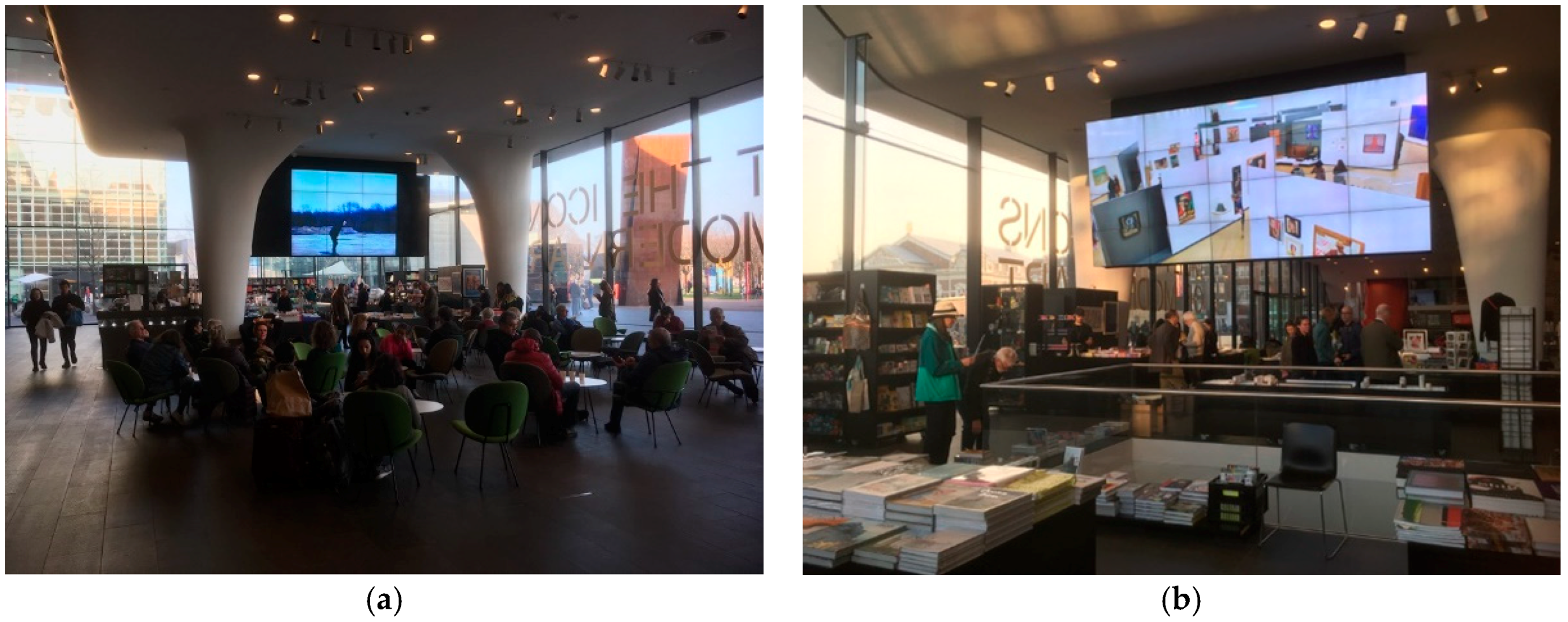1. Introduction
In this essay, I address the way in which one art institution—the Stedelijk Museum in Amsterdam—has dealt with time-based media, from early video art to the newest forms of digital art. The Stedelijk, as the museum is known locally, makes an interesting case study for exploring the current status of new media and digital art within a museum context, because it not only grapples with the same questions of digitally based art as most other museums of modern and contemporary art but also has had a reputable history of collecting and exhibiting time-based media since the 1960s and 1970s. Focusing on ‘new media and digital art’ (the more contemporary terms for ‘time-based media’)
1 in a museum such as the Stedelijk, with its renowned collection and distinct exhibition history, allows us to discuss the task of curating and collecting these new forms of artistic expression in the digital era more concretely.
In the key literature on the challenges for modern and contemporary art museums in regard to new media and digital art, the need for serious institutional reflection on existing curatorial models and collection policies have been stressed by many experts, such as Beryl Graham, Sarah Cook, and Christiane Paul. In “Challenges for a Ubiquitous Museum: from the White Cube to the Black Box and Beyond” (2008), Paul—the adjunct curator of new media arts at the Whitney Museum of American Art—stated that “there is no doubt that traditional museums must transform themselves if they want to accommodate new media art” (
Paul 2008, p. 53). So, where do museums of modern and contemporary art stand with respect to implementing changes as of 2019?
The Stedelijk’s history of time-based media began in 1974, when the museum appointed its first curator for the department of painting, sculpture, and video: Dorine Mignot (
Figure 1).
2 Mignot’s long-term position as curator of time-based media at the Stedelijk, from 1974 to 2006, heightened her expertise on time-based media within the visual arts while simultaneously bolstering the museum’s reputation in this field. Mignot began curating and collecting performance and video art in the mid-1970s but quickly expanded her area of interest to multi-media installations in the 1980s and 1990s.
A few years before Mignot’s retirement, the Stedelijk was closed for almost a decade (from 2004 to the fall of 2012) due to the renovation of the historic building and the construction of a new wing, but under the leadership of Beatrix Ruf, director of the Stedelijk from November 2014 to November 2017, an ambitious agenda was once again set for curating and collecting new media and digital art (
Figure 2). Ruf also appointed a new curator for time-based media, Karen Archey—a prolific American critic and curator affiliated with post-internet art.
3Introducing the Stedelijk as a case study, in this essay, I aim to explore some of the questions raised in this Special Issue on “Art Curation: Challenges in the Digital Age”, such as the following: “Are ‘conventional’ or ‘old media’ curatorial approaches still relevant or necessary when curating digital art?”; “What are the issues involved in re-contextualizing and exhibiting pioneering artworks made in the 1960s and 1970s?”; and the umbrella question “What are [adequate] curatorial approaches regarding digital art?”
4 I will begin by sketching an outline of the Stedelijk’s history of timed-based media from the basic premise that the museum’s exhibition program and collection are interrelated and that curatorial strategies and collection policy are shaped in tandem. This connection is still the same for a relative ‘new-comer’ such as digital art today. That an exhibition program is linked to a museum’s collection policy when evaluating new media and digital art in an art museum is confirmed by Beryl Graham and Sarah Book in their book
Rethinking Curating; Art after New Media, in which they declare that museums are “largely defined by their collection, but many [have] yet to start creating a collection of new media art” (
Graham and Cook 2010, pp. 202–3). The Stedelijk does have a collection policy for new media and digital art (or ‘time-based media’, as the museum still calls this part of the collection), but issues and concerns remain regarding the relationship between the ‘old’ and ‘new’ media (or ‘mediums’)
5 and the dialogue between the collection and exhibitions. All of this results in the slightly revised question: What are convincing approaches in regard to curating and collecting digitally based art in a museum of modern and contemporary art, such as the Stedelijk, considering the continuing interchange between the collection and the exhibition program?
2. From Time-Based Media to Digital Art
Digital art has a history or even “media art histories”.
6 In the essay “New Media Art and the Gallery in the Digital Age”, Charlie Gere reminds us of the intertwined histories of art, media, and technology, which began in the postwar period with developments in cybernetics and information theory (
Gere 2004, also published in
Paul 2008). The different arts respond to these new technological developments, and since the 1960s, the intricate intersections of art and technology have created a lively and productive artistic climate of new media art, including video, slide, film, audio, and computer. Gene gives a quick survey of the artistic explorations and pioneering exhibitions in the 1960s and 1970s in the United States (US) and Europe—the fine-meshed network of which is further disclosed in
Mainstream Experimentalism (
Higgins and Kahn 2012).
The collection history of time-based media at the Stedelijk began with television, video, and performance art in the 1960s and 1970s but continues up to today with digitally based, multi-media installations, internet art, and other forms of (interactive) digital art. The museum’s collection of time-based media encompasses seven types: single-screen video, single-screen films, audio, slides, installations, computer and internet art, and performances and other choreographic projects. During the formative years of this relatively young collection, Mignot’s position was not exactly easy. This is evident from the introductory essay in the catalog of Mignot’s pioneering show ‘The Luminous Image’ (1984), in which former director Edy de Wilde states: “The Stedelijk has paid regular attention to the medium of video,
not because the medium as such would be of any artistic significance [emphasis added], but because a number of important artists have made use of it” (
De Wilde 1984, p. 5)
7—a disclaimer that he would probably never use for painting. De Wilde’s well-intended words do not point to a great commitment to time-based media, even if he supported video and performance art throughout his time at the Stedelijk. Yet, he was himself primarily interested in postwar painting. This is clear not only from the many masterpieces of European and American paintings that he secured for the museum but also from his farewell show ‘La Grande Parade’ (1984), which was a full-fledged homage to postwar painting, including the works that he acquired for the museum but excluding time-based media and other forms of experimental art. So, Mignot deserves full credit for resolutely advocating for time-based media for the Stedelijk, at a time when the collection was still in its infancy. While the Stedelijk began collecting film and video in the 1960s, due to groundbreaking exhibitions, such as ‘Dyllaby’ (1962) and ‘Op Losse Schroeven’ (1969), the collection and exhibition program were only enhanced and consolidated under Mignot. She started in 1975 by simply buying video tapes from artists such as Bruce Nauman and Vito Acconci, the latter of whom she offered his first European solo in 1978. This was followed in the same year by an exhibition of another pioneer of video art, Nam June Paik, to whom the Stedelijk owes its first, undisputed collection highlighting time-based media: TV Buddha (1972) (
Figure 3). Besides curating exhibitions, Mignot lobbied for a separate space for video. In her “proposal for a video-space” from 1980, kept in the Stedelijk’s archive, she explained her final choice for the space underneath the central staircase of the museum, which indeed for years served as the formal space for showing video art. “Upon closer consideration”, Mignot wrote in the proposal, “this space is really the most suitable, due to its closed character, its central location, and the waywardness of the space, which can hardly be destined for something else” (
Mignot et al. 1980).
In the 1980s, Mignot curated two exhibitions that were picked up internationally: the abovementioned ‘The Luminous Image’ (1984), and ‘The Arts for Television’ (1987). The first show was groundbreaking in the sense that the participating artists and the curator took new media out of the video tape sphere and expanded time-based media to multi-media installations. In Mignot’s words:
Video has come to be recognized as one medium alongside many others and we have become accustomed to it as such. No rush on high-tech studios or obsessions about television transmission, but explorations in the direction of the synthesis of a personal contact with the electronic medium. The showing of that tendency is the basic aim of this exhibition. And in this we have chosen on video installations rather than video tape because it is precisely installations that express the tendency described above. (
Mignot 1984, p. 10)
Installations of some of the most important video artists at that time were presented in the show, such as Vito Acconci, Marina Abramović and Ulay, Tony Oursler, Bill Viola, Robert Wilson, and many others. The second exhibition, ‘The Arts for Television’, was well timed and traveled, for example, to the MoMA in New York, where it was integrated into a survey exhibition and a video program related to the different arts for television.
8 Based on her research on the legacy of Mignot in the museum’s archives, current curator Karen Archey noted the following with respect to the television show:
The exhibition debuted at the Stedelijk in October 1984 and continued its tour through the rest of the ‘80s. It was a charged moment: MTV’s launch in 1981 was changing the scope of television, the support for artists working with public broadcast TV at stations such as Boston’s WGBH and New York’s WNET was drying up as cable debuted and television was becoming increasingly corporatized. (
Archey 2017)
When video developed into a dominant art in the 1990s, Mignot shifted course once again and began focusing on shows with artists who were meanwhile canonized as the masters of video art, such as Gary Hill (1993), Joan Jonas (1994), and Bill Viola (1998). ‘Bill Viola: A 25-year Survey’ (1997) was a blockbuster show curated by the artist and theater producer Peter Sellars for the Whitney Museum, which afterwards traveled to the Stedelijk (1998) (
Figure 4). The importance of Mignot’s work for both the Stedelijk Museum and time-based media art was acknowledged in the Netherlands, including by the artistic circles that were on the forefront of experimenting with television, video, and performance art in the Netherlands, such as the De Appel Foundation and Montevideo. As Dutch video art critic Pauline Terreehorst recalls of this period: “The museums steered a rather prudent course in regard to video, with the exception of the Stedelijk Museum (…). The Stedelijk Museum was the only museum that developed an acquisition policy, and regularly followed the changes within video art, presenting it in large, crowd pulling exhibitions” (
Terreehorst 1991, p. 65).
The reason to discuss Mignot’s tenure at length is that this very first curator of time-based media at the Stedelijk has not yet received the attention that her significant contribution to the museum deserves. Mignot unfortunately did not have a farewell exhibition and catalog in which she could have shown and documented her steadfast work regarding time-based media over the span of three decades (as De Wilde did for painting in ‘La Grande Parade’), nor has a professional biography on her life and work been written.
9 The accomplishments of other pioneering curators of new media and digital art have similarly not received proper critical attention as of yet, especially not since the development of new media and digital art in the 1990s. “Art museums are largely defined by their collections”, as Graham and Cook state, but these collections in turn are largely determined by the curatorial visions and collection policies of specific curators. “One obvious role played by art museums”, Graham and Cook continue, “is that of historization” (
Graham and Cook 2010, p. 138). A well-researched anthology on important and groundbreaking new media curators and their exhibitions and curatorial models and approaches in Europe and the US (and possibly beyond) could be a welcome addition to the literature on new media and digital art in the context of museums of modern and contemporary art.
Fast forward to November 2014, when Beatrix Ruf was appointed director of the Stedelijk Museum. Ruf’s directorial post was overshadowed by her resignation a mere three years later because of the assumed conflict of interest between her role as museum director and her activities as a private art consultant in her own firm
Currentmatters—all of which was declared unfounded by an independent investigation by the city of Amsterdam in 2018.
10 In her brief tenure as director of the Stedelijk (from November 2014 to November 2017), Ruf achieved remarkable things for the museum, such as the acquisition of the Borgmann collection and a new curatorial approach to the permanent collection in the so-called ‘Stedelijk Base’, developed by AMO architects Rem Koolhaas and Federico Martelli (
Figure 5).
‘The Base’ is part of a total re-organization envisioned by Ruf for the whole of the Stedelijk Museum. The new spatial design is divided into three units: ‘Stedelijk Base’ (the collection in the basement and the first floor of the new wing), ‘Stedelijk Turns’ (for temporary exhibitions based on the collection on the ground floor of the historic building), and ‘Stedelijk Now’, dedicated to contemporary art (the first floor of the same building). Besides the experimental design by AMO for the Base, Ruf also laid the seeds for an innovative agenda for new media and digital art, especially in the ‘Stedelijk Now’ section. Because the museum was closed until 2012 and the first director after the reopening, Ann Goldstein, focused more on conceptual art and its legacies (which have a strong tradition in the Netherlands), Ruf was the first director to methodically respond to digital developments in the visual arts. In the lifestyle magazine
Deluxe of the Dutch newspaper
NRC, Ruf presented her curatorial vision in 2015, including a list of artists. On this list were several artists working with digital media, such as Ed Atkins and Seth Price, both of whom were offered their first solo at the museum in 2015 and 2017, respectively. Ruf also gave solos to other—mostly ‘digital native’—artists via the innovative program ‘Stedelijk Contemporary’, such as Jon Rafman (2016), Avery Singer (2016), and Jordon Wolfson (2017). The one-year-long, prize-winning exhibition of Tino Seghal should be added to this list, even if his intimate choreographed situations do not directly address ‘the digital’ but rather the diminished physicality of our mediated world, in the sense that he creates interactive environments and performances, where the public is drawn into a variety of ‘real-life’ physical and sensorial experiences.
11While one does not necessarily have to agree with all of Ruf’s choices—the canon of digital art is still very much in flux—and one could criticize the lack of a historical framework on the basis of which these choices were made (all of these artists were simply very much in vogue during Ruf’s tenure), there is no doubt that she fully recognized that museums are, in Gere’s words, “profoundly affected” by technological developments, which “present particular challenges to the art gallery as an institution” (
Gere 2004). By exhibiting the work of the abovementioned digital artists, the Stedelijk convincingly addressed Claire Bishop’s criticism on digital art expressed in her essay ‘Digital Divide’ (2012):
So why do I have a sense that the appearance and content of contemporary art have been curiously unresponsive to the total upheaval in our labor and leisure inaugurated by the digital revolution? While many artists
use digital technology, how many really confront the question of what it means to think, see, and filter affect through the digital? How many
thematize this, or reflect deeply on how we experience, and are altered by, the digitization of our existence?” (
Bishop 2012)
In his large-screen video environments, produced with advanced digital technology, Atkins, for instance, questioned the way in which online existence intrudes upon our daily lives and therefore “alters” our experience. Using avatars and other digital stand-ins, the artist made online cultures experienceable in exhibition spaces (through life-size screens, the direct address of the virtual personae, etc.), from Facebook’s simple ‘thumbs-up’ feature to the complex and disturbing culture of trolling. In Ruf’s words: “With his work, Atkins explores the virtuality of our contemporary visual world and its profound effect on the reality of our embodied lives. His high-definition videos and powerful sound-tracks address existential questions about how love, sex, death, and relationships are experienced in the face of digital abstraction”.
12 In addition to this, the exhibition presented rather innovative installations in which new spatiotemporal relations linked to the complexity of online experiences were being investigated through differently seized and grouped projection screens in a labyrinthine set up. Wolfson was another artist on Ruf’s list, who is invested in the increasing digitalization of culture and society, especially robotization. In the Stedelijk, the artist presented two confronting animatronic sculptures, that is, a new kind of Hollywood- or amusement park-inspired moving sculpture, controlled and steered by robotics. Both of these robots—a female figure/porn star dancing in front of a mirror and a colorful boy hanging in heavy chains from the ceiling while constantly being dropped onto and tossed around on the floor—interacted with the public through face-recognition software, which triggered all kinds of physical reactions, uncanny feelings, and sheer emotions in them (
Figure 6). Canadian artist Jon Rafman also addressed today’s online world in participatory installations, such as an artificial bubble bath in which you could sit and relax while watching YouTube clips on crazy subcultures, all of which resonated with a young crowd who visited the museum in greater numbers than usual (
Figure 7). According to Paul, engaging new audiences is “An important step in getting new media art out of its ghetto and integrating it into the artworld (…)” (
Paul 2008, p. 66). She is especially referring to an audience who grew up with internet culture: “The online, virtual audience for software, Internet, and game art mostly consists of self-organizing communities of interest that are embedded in different ‘networked cultures’” (ibid.). Through innovative installations on the threshold of online and offline worlds, which make online communities experienceable in the gallery space, Rafman succeeded in attracting fans of internet cultures to the museum.
From her first day at the Stedelijk, Ruf made a point of bringing more female artists into the museum, both in the collection and in the temporary exhibition program. Her first purchase for the collection was the painting
Zwei Lampe (1994) by the German artist Iza Genzken, followed by a large retrospective of Genzken’s work titled ‘
Mach dich Hubsch’ (2015–2016). Other solo exhibitions by female artists and photographers followed, such as Rineke Dijkstra, Nalini Malani, and Zanele Maholi. The female perspective was also extended into the digital field, where another remarkable solo was Avery Singer’s show with digital chiaroscuro paintings, titled ‘Scenes’ (2016) (
Figure 8). Her digitally produced paintings, made in an exclusive palette of gray tones in the three-dimensional (3D) design software program SketchUp, demonstrating that digital painting is not only alive today thanks to ever-more sophisticated digital software and tools but also begins to create interesting relationships with the entire tradition of modern painting. In ‘Love of Painting’, German critic Isabelle Graw identifies Singer’s work as nothing less than ‘network painting’ (a term coined by David Joselit in 2009) and states her art-critical belief in “the fusion of the terms ‘network’ and ‘painting’”, because it “does away once and for all with the modernist ideal of a clearly delimitable sphere of pure painting” (
Graw 2019, p. 265). Depicting social environments full of references to art history and the art world, Singer’s work is indeed based not on an abstract idiom but on what Graw further describes as “a web of social relationships” (ibid., p. 266).
The reason to discuss these exhibitions on digital and related art at the Stedelijk in detail is because Ruf’s short tenure was eclipsed by the abovementioned drama surrounding her resignation, which was followed by an institutional crisis at the museum. In the start of 2019, a statement was released stating that both parties were willing to “leave the past behind”, meaning that Ruf does not return to the museum. The newly appointed director, Rein Wolfs, will begin his position at the Stedelijk in December 2019. Due to this unsettling course of events, Ruf’s substantial contributions to the museum have not been sufficiently reflected upon in the art press, let alone digested by the Dutch art world and beyond. Ruf’s innovative approach to new media and digital art alone demonstrates the very ambitious program that she had in mind for the years to come. Young artists were given ample space to present their experimental work, which unmistakably belongs to the digital age. Ruf also acquired works by most of these artists for the Stedelijk’s collection, such as three artworks by Atkins and a large-scale painting installation by Singer. The Stedelijk’s collection and exhibition program had briefly ‘gone digital’ due to Ruf’s forward-looking advocacy for digital art, strengthened by an active acquisition policy. The latter was boosted even further in 2016 through a collaboration with the Museum of the Image (MOTI), with which the Stedelijk purchased a substantial collection of 17 digital art projects related to the internet, from Net.art in the 1990s (Vuk Ćosić, JODI) to Net Art 2.0 (Rafaël Rozendaal, Olia Lialina), and ‘post-internet’ art (Constant Dullaart, Jon Rafman).
13 3. Collecting and Exhibiting New Media and Digital Art
This short tour through the history of new media and digital art at the Stedelijk brings me back to my question as to how to curate and collect digital art, considering that the collection and the exhibition program are in an ongoing dialogue with one another. Ruf acknowledged this universal trait of museums of modern and contemporary art when she redesigned the museum according to the tripartite design model of ‘Stedelijk Base’, ‘Stedelijk Now’, and ‘Stedelijk Turns’. The first two have already been discussed above: ‘Stedelijk Base’ focuses on the Stedelijk’s permanent collection (collection highlights, art historical canon) in the basement and the first floor of the new wing, while the second refers to various temporary exhibitions with contemporary artists or designers, which take place on the first floor of the historic building. ‘Stedelijk Turns’ hovers in between the two, as it consists of temporary exhibitions (or ‘turns’) based on the permanent collection (rarely exhibited works, unexpected themes, new curatorial approaches, etc.) and is located on the ground floor of the old building, sandwiched between the basement of the new wing and the first floor of the historic part.
My brief historical account indicates that, as of 2019, the Stedelijk is capable of mounting exhibitions of digitally based art, whether internet art, database art, or installations produced with advanced digital technology—it has the in-house technical staff and ever-expanding know-how. The collection and exhibition program regarding new media and digital art have also notably developed in recent years. To show these exhibitions and presentations of new media and digital art, the museum makes use much more frequently of black boxes instead of white spaces. Besides the collection of objects and the exhibitions mentioned above, more has been done over the years, such as shows by other curators of the museum or by guest curators, in which new media or digital art play a role, such as ‘Wild Walls’ in 1995 (Martijn van Nieuwenhuyzen and Leontine Coelewij), the Warhol exhibition entirely dedicated to the artist’s time-based art in 2006 (guest curator Eva Meyer-Hermann), ‘Deep Screen: Art in Digital Culture’ (guest curator Andreas Broeckmann), or the large video installation exhibition of Aernout Mik in 2016 (Mik and Coelewij), to mention only a few. There have also been interesting exhibitions with new digital forms of (graphic) design, such as ‘TYPE/Dynamics’ of the Dutch design collective Lust (2014), ‘Using Type’ on Philippe Apeloig (2016), by curator Carolien Glazenburg, the popular exhibition ‘Coded Nature’ of Studio Drift (2018), co-curated by Ingeborg de Roode and Pao-Lien Dije, and the show on Metahaven in 2019, curated by Karen Archey. There is of course the ever-expanding collection of new media and digital art, with historical video and performance art from the 1960s and 1970s, multi-media installations from the 1980s and 1990s, hybrid art forms that have emerged since the 1990s, and digital art from the first decade of the 21st century onward, which have increasingly been purchased in collaboration with other Dutch museums. Four artworks by Hito Steyerl, for example, were jointly acquired by the Stedelijk and the Van Abbemuseum soon after Beatrix Ruf’s appointment in 2014.
Given this expanding collection and intensified exhibition program regarding digital art and design, what are the challenges and obstacles that remain, if any? While the Stedelijk has finally ‘gone digital’ under Ruf, she did not have time to consolidate this new approach or integrate it to the fullest in the new spatial design. Time-based art is clearly underrepresented in the permanent collection, which can be quickly illustrated by two examples: first by the presentation of conceptual art and second by the added sections on digital art. Conceptual art, as said, has an incredibly interesting history in the Netherlands, especially related to the Stedelijk in the 1960s and 1970s, which is recognized internationally. During this time, the Stedelijk carved out a space for itself on the international scene and established itself as one of the defining institutions for modern art in Europe. Dutch conceptual art had an important role in this narrative, as the MoMA show ‘In and Out of Amsterdam’ (2009) on conceptual art trends in the Netherlands showed. Moreover, Wim Beeren’s controversial exhibition ‘Op Losse Schroeven’ (1969), which is a milestone exhibition in the history of conceptual art, has achieved almost cult status. Works from the museum’s rich collection from this period, including the vast collection of video tapes, however, are confined to a bland side space of the Base (
Figure 9). Loops of signature videos of Dutch conceptual artists, such as Jan Dibbets and Marinus Boezem, are shown next to their international counterparts on four small monitors in a user-unfriendly program, alongside rudiments of important historical installations, such as the model of the seminal staircase intervention by Ger van Elk. Perhaps the idea is that we must be happy that conceptual art gets space in the Base at all. Or that, in this way, at least the video and television collection can be seen by patient conceptual art lovers? This curatorial model, in the spirit of Mignot’s video programs below the staircase, may have been the best available solution to the limited space allotted to this controversial yet heroic time in the Stedelijk’s history but is far from an imaginative curatorial approach to conceptual art. Radical conceptual art videos are rather put in a straightjacket to fit into a museum collection presentation, thereby losing much of their artistic force. Conceptual art has a close connection with new media art from the 1960s and 1970s, and its innovative ideas on (immaterial) artwork and art documentation, together with the development of new exhibitions and communication models that intersect with new media culture, system theories, and software programming, have had a huge formative influence on digital art in the 1990s and beyond. However, no connection is established in the Base between (historical) conceptual art and new media and digital art.
While the times when media art was hidden below the staircase might be over, digital art from the 1990s is similarly put in a small transition space in the Base upstairs—a kind of walk through to the cinema theater. Here, internet art is presented in a beautifully executed yet straightforward design on high-quality horizontal computer screens (one next to the other, just like the video tapes on the monitors downstairs) and opposite to a cluster of postmodern chairs and other unrelated design objects. In 2008, Christiane Paul concluded that the presentation of internet art challenges the museum or gallery space the most (
Paul 2008, p. 57). However, she offers many different curatorial options for exhibiting different types of internet art, such as presentation in an interactive installation based on advanced interfaces; a computer on which net art projects can be visited and explored individually; and large-screen projections. Symptomatic of the unimaginative approach of the Stedelijk to internet art is the presentation of an internet art project by Rafaël Rozendaal titled ‘Abstract Browsing, 16.03.08 (Reddit)’ (2016) (
Figure 10). The work is part of a series of paintings, in which a layering of ‘abstract windows’, typical of the underlying structure of the internet, are printed out and woven into, a canvas, with which Rozendaal draws an analogue between pixels on a computer screen and weaving patterns—machine-made and man-made works of art. Rozendaal is an artist who declares the internet as his canvas, and on its website, the Stedelijk recognizes that Rozendaal is inspired by modern painters, such as Malevich and Mondrian—the artistic dialogue with the latter is in fact hard to miss, as the internet artist offers us a digital upgrade of Mondrian’s abstract logic on the web. Despite this apparent response to, and emulation of, models of modernist painting, Rozendaal’s beautifully woven canvas (or wall tapestry) is squeezed into the same space with internet screens and design objects, on the dead inches of the white wall, next to the door opening to the programmatically more significant space of the Base for postmodernist art. Evidently, the museum has to make tough choices as to which artworks from its 90,000-item collection to exhibit in the permanent collection, but the curatorial approach towards new media and digital art is clear enough: this part of the collection is not truly seen or treated as an ‘artistic equal’ to other kinds of collections, especially painting and sculpture.
Yet, the Stedelijk does explore new creative ways to accommodate new media and digital art in other spaces. In the entrance lobby of the new wing, for example, a digital screen hangs from the ceiling between the bookshop and the seating area (
Figure 11). On the side of the seating corner, ‘old’ and ‘new’ video tapes are shown in endless loops throughout the opening hours, with work from major video artists, such as Bruce Nauman and Douglas Gordon, to lesser-known works from the timed-based media collection, such as ‘Man and Dog’ (2002) by Dutch artist Pauline Oltheten or unfamiliar video tapes of internationally recognized artists, such as Martha Rosler’s ‘Flower Fields’ (1975). The other side of the same screen, on the bookshop side—which can also be viewed through the glass curtain wall from outside of the museum—is used as a billboard for glimpses of the permanent collection or ads of current exhibitions. The double-sided screen can also turn into a stage set for a VJ performance at an opening night. Altogether a screen for multi-purpose display, which perfectly fits the shifting functions of the entrance zone of the building, is a modest first step and hands-on approach to the question of ‘re-contextualizing and exhibiting pioneering artworks made in the 1960s and 1970s’.
In the wooden cinema theater on the first floor of the new wing, films and video from the time-based media collection are continuously projected onto a film screen. However, the question remains if these traditional screens (whether the billboard in the main hall or the cinema on the first floor), and this particular mode of projecting digital art are sufficient for the digital era, which authors such as Peter Weibel and Lev Manovich have characterized as the “post-media age”. In his book
Between Film, Video, and the Digital, Jihoon Kim more specifically describes this post-media condition as “[A] situation in which digital technologies serve as an environment in which techniques and aesthetic features of a media are dislocated from its medium-specific boundaries and become increasingly hybridized with those of other media” (
Kim 2016b, p. 15). Because there are many ways in which contemporary digital art cuts across media, genres, and platforms, more daring curatorial approaches for new media and digital art seem called for in a contemporary art museum such as the Stedelijk. Following the example of SFMOMA in the early 2000s, a good and constructive next step could be to take new media and digital art out of the spatial niches and the cinema theater format and allot some permanent gallery spaces for exhibiting new and innovative art forms from the collection until the museum has figured out the role and place of new media and digital art in that collection.
4. Conclusions
One conclusion of this essay is that the Stedelijk has had a thought-provoking exhibition program regarding new media and digital art in recent years but that this program does not translate as of yet into a convincing curatorial vision for the collection as a whole: the permanent collection does not treat new media on the same footing as traditional art forms, and there is little dialogue between ‘old’ and ‘new’ media. These kinds of issues are not specific to the Stedelijk, but rather pose a continuing challenge to the whole museum field, because exhibiting and collecting new media and digital art require new policies and approaches, a well-equipped technical department, and new historical narratives for the collection. In addition, museums need more cross-departmental communication and networking to integrate new media and digital art into the museum as a whole, from the gallery spaces to the public programming and from the library and the website to alternative online spaces. “New media art”, as
Graham and Cook (
2010, p. 94) put it, “can push the boundaries not only between curatorial departments, but also between all departments of an institution”. This is an institutional route that the Stedelijk has certainly taken since 2010, especially in terms of linking exhibitions with the public program of lectures, performances, discussions, and symposia, including the special Friday evenings when temporary new media and digital art events also play a role.
14Another possible route for the museum would be to reevaluate ‘Stedelijk Turns’ (if the museum layout of ‘Base’, ‘Turns’, and ‘Now’ will be kept by the next director) from the perspective of new media and digital art, because these flexible collection-based exhibitions are able to form interesting links between the exhibitions and the collection, including new media. This curatorial approach to ‘Stedelijk Turns’ could go in two directions. One the one hand, it could strengthen the link between the temporary exhibitions and the collection. For example, from May to October 2019 the museum is hosting the exhibition of Walid Raad, ‘Let’s be honest, the weather helped’. The Stedelijk has a substantial amount of post-media art in its collection that intersects with Raad’s theme of fundamentally questioning the porous borders of reality, fiction, and history in the context of war (the Lebanese civil war in Raad’s case), such as Aernout Mik’s ‘Raw Footage’ (on the Yugoslavian war) or Juul Hondius’ ‘Brilliant Punitive Raids’ (Israeli–Palestinian conflict). All of these artists use documentary means and reconstruct events on partially fictive, partially evidence-based images so as to interrogate the complexities of the whole idea of ‘truth’ today. These artists are all concerned about the status and proliferation of the (mediated) image in the digital age and investigating political situations and contemporary events through new artistic strategies toward photography and what Jihoon Kim terms ‘hybrid moving images’: “an array of impure image forms characterized by the interrelation of the material, technical, and aesthetic components of moving image media—namely film, video, and the digital” (
Kim 2016a, p. 3). The documentary approaches of these artists represent a certain artistic trend in contemporary art, which is well represented in the time-based media collection of the Stedelijk. Mobilizing this collection for thematic, aesthetic, technological, and conceptual links with a central exhibition could help close the gap between the exhibition program and the media and digital art collection over time.
On the other hand, linkages between the historical time-based media collection of video and performance art and the contemporary exhibition program related to new media and digital art could be strengthened in the context of Stedelijk Turns. Ed Atkins, for instance, received a blockbuster show without much historical context, even if his work triggers all kinds of interesting dialogues with the historic collection of time-based media of the museum, such as the work of Nam June Paik and Bruce Nauman. Atkins, after all, is not an isolated genius who reinvents art history. In his spatiotemporal installations, created with the newest digital means, he is responding to the video installations of his predecessors. In the chapter “Installing time” of her book
Screens, Kate Mondloch cites an interesting statement of Daniel Birnbaum, director of the Moderna Museet in Stockholm: “Installing time is a matter of choosing the right spatial model, the most adequate ‘schematism’, allowing the translation of temporal properties into space” (
Mondloch 2010, p. 40). In his solo at the Stedelijk, Ed Atkins showed himself to be a master choreography of spatiotemporal experiences through his layered design of differently sized screens across the space—large screens, multiple small screens, obliquely placed screens, screens directly on the floor, classic double screens, etc. Together these innovative installations created new spatiotemporal experiences for the spectator, which are indebted to Bruce Nauman’s ‘Live-Taped Video Corridor’ (1970) and other historical video installations of Nauman, Gary Hill, and Bill Viola. However, Atkins’ installations also intersect with of a range of multi-media installations created since the late 1990s by artists such as Eija-Liisa Ahtila, Tacita Dean, and Sam Taylor Wood, which understandably serve as case studies in Mondloch’s book.
Mobilizing ‘Stedelijk Turns’ more actively to address the gaps between the collection and the exhibition program is a strategy to bring them closer together in a dynamic and interactive way and to start to rethink the permanent collection or “Base” from the perspective of media history on a higher intellectual level than just adding a video program or internet site here and there in the permanent collection. The culture and society of the 20th and 21st centuries require a reflective and critical approach towards the increasingly technologized world in which we live. Or, as
Gere (
2004) quotes cultural theorist Andreas Huyssen, “a place of resistance to” and a “contemplation outside” of “the effects of accelerating technical processes”.
This would include a critical reflection on the omitted artworks in this media historical narrative, especially concerning the beginnings of the digital developments in the 1990s, which, judging from the video and new media exhibitions in that crucial decade, were not really picked up or fully recognized by Mignot.
15 Internet art and other ‘avant-gardist’ digital art took place in the niches of the Dutch art world, in new media festivals (ISEA and Ars Electronica), alternative spaces (Transmediale), and media labs (V2). Walter Benjamin already realized that the first decade of a new technology is often the most interesting, because there is an explosion of inventiveness—a time of experimenting, imagining, and envisioning the creative potential of that new technology. The Stedelijk missed the boat in this foundational decade and therefore has a gap in its collection regarding the cradle of digital art, even after the purchase with MOTI of a key collection of internet art.
In the above line of argumentation, the Stedelijk has served as a case study to investigate questions such as whether old media curatorial approaches are still relevant when curating digital art; how we can reconsider early media art history in the face of the present, and which curatorial decisions or steps this could involve. What are meaningful curatorial approaches regarding digital art, if the advent of ‘the digital’ is also put in historical context? My position throughout this essay has been that the answers to these important questions need to be found within specific museum contexts—the situation of Eye Filmmuseum (another major museum in Amsterdam, which has quite a dynamic exhibition agenda for film, video, and digital art installations), for example, is completely different than that of the Stedelijk. As the museum of the moving image, Eye can often be more daring, dynamic, and imaginative in its curatorial approaches than the Stedelijk, because it is less burdened by a renowned collection and history. A comparative approach, however, has not been the methodological approach of this paper, which rather traces the way in which one museum—with a track record of openness to artistic innovation and experimentation—has responded to the ever-increasing digitalization of the arts and culture and its consequences for museums of modern and contemporary art. Museums with larger budgets than the Stedelijk, such as MoMA and the Tate Modern, can “transform themselves” (Paul) more quickly to the institutional needs of new media and digital art, although it must be added that the Whitney Museum and a bunch of smaller institutions, such as SFMoMA, the Walker Art Center, and Eyebeam, have paved the way through their relatively early embrace of new media and digital art. Now, in 2019, museums and other art institutions share the responsibility to show and address the increasing impact of technological culture on the arts, culture, and society at large.
